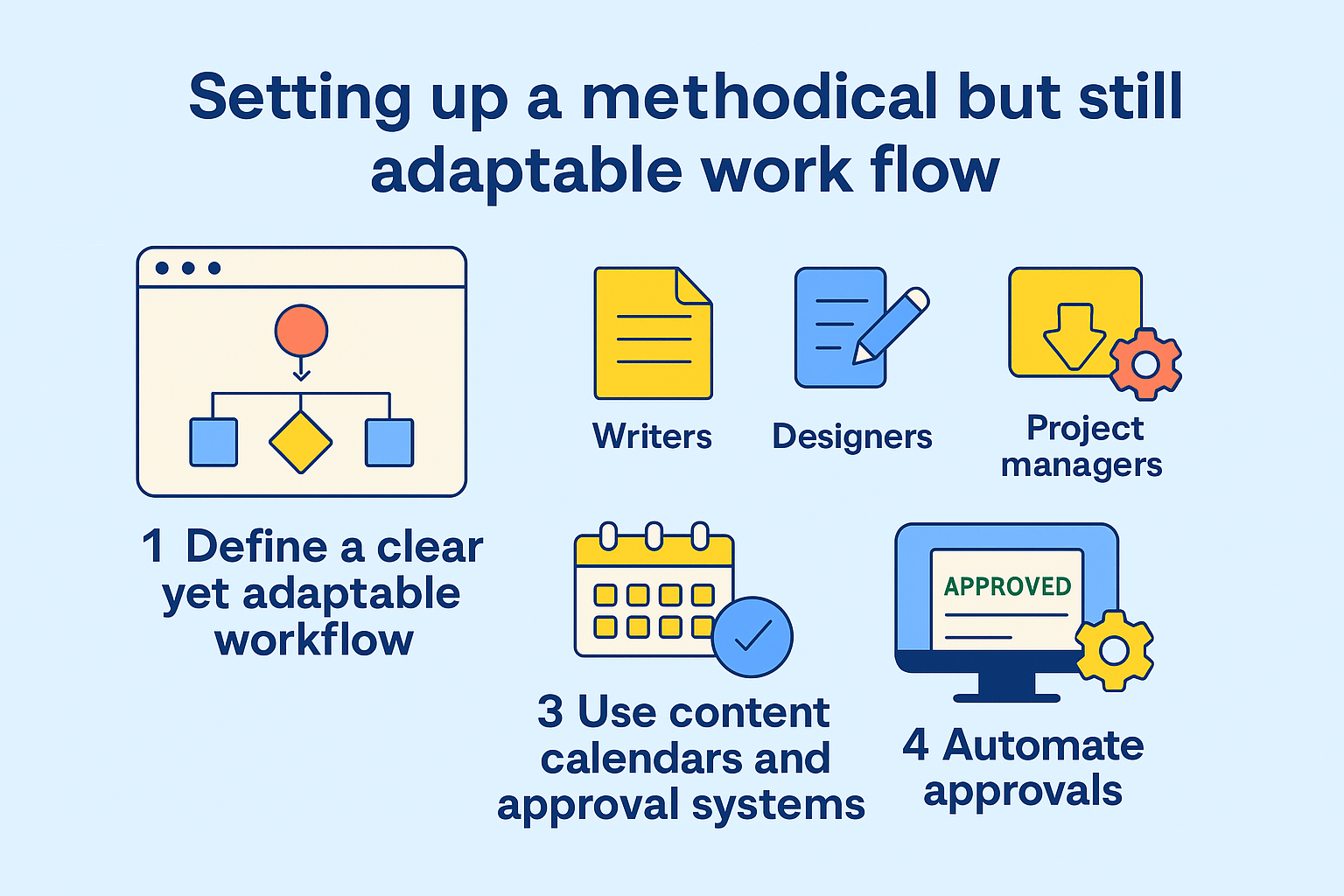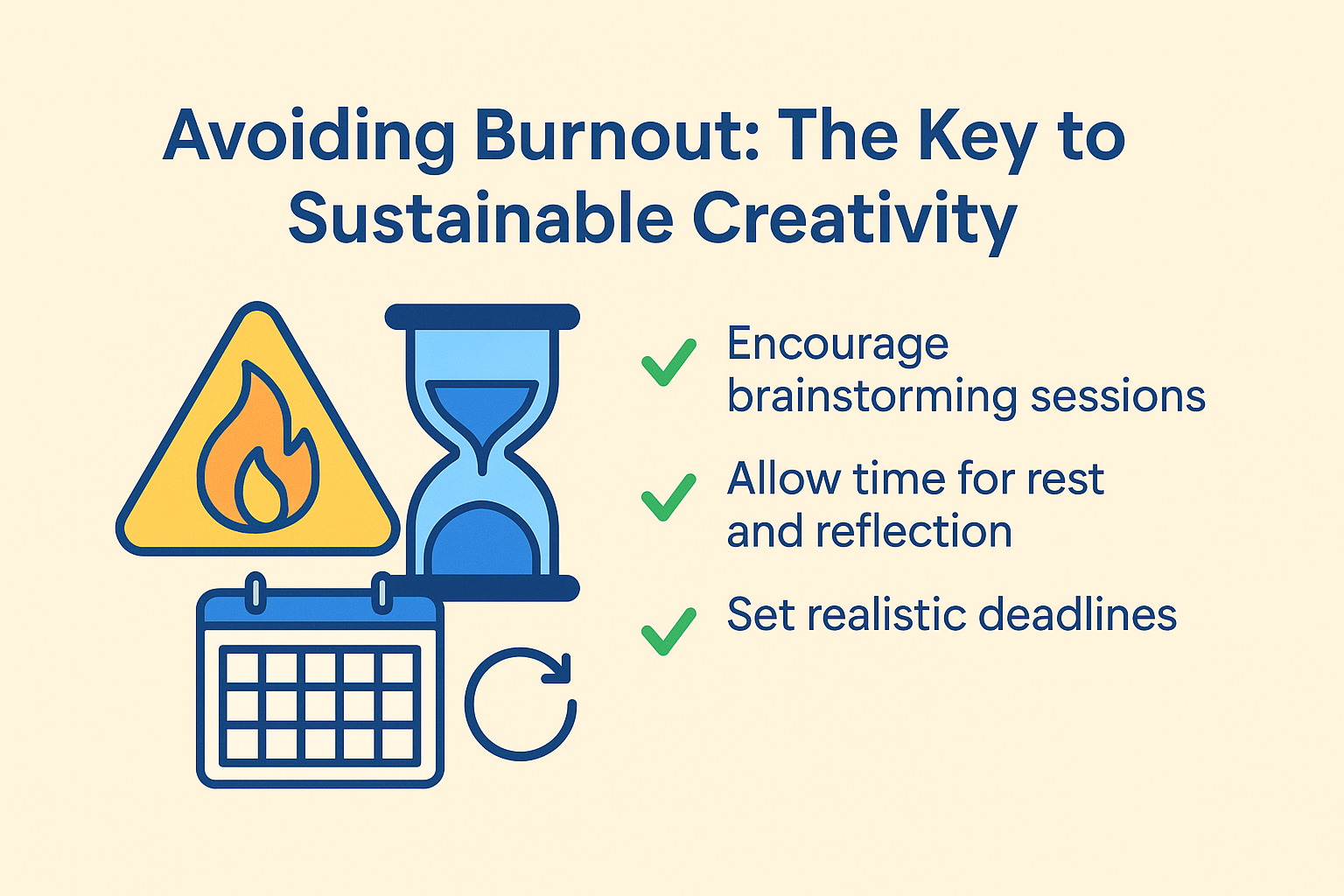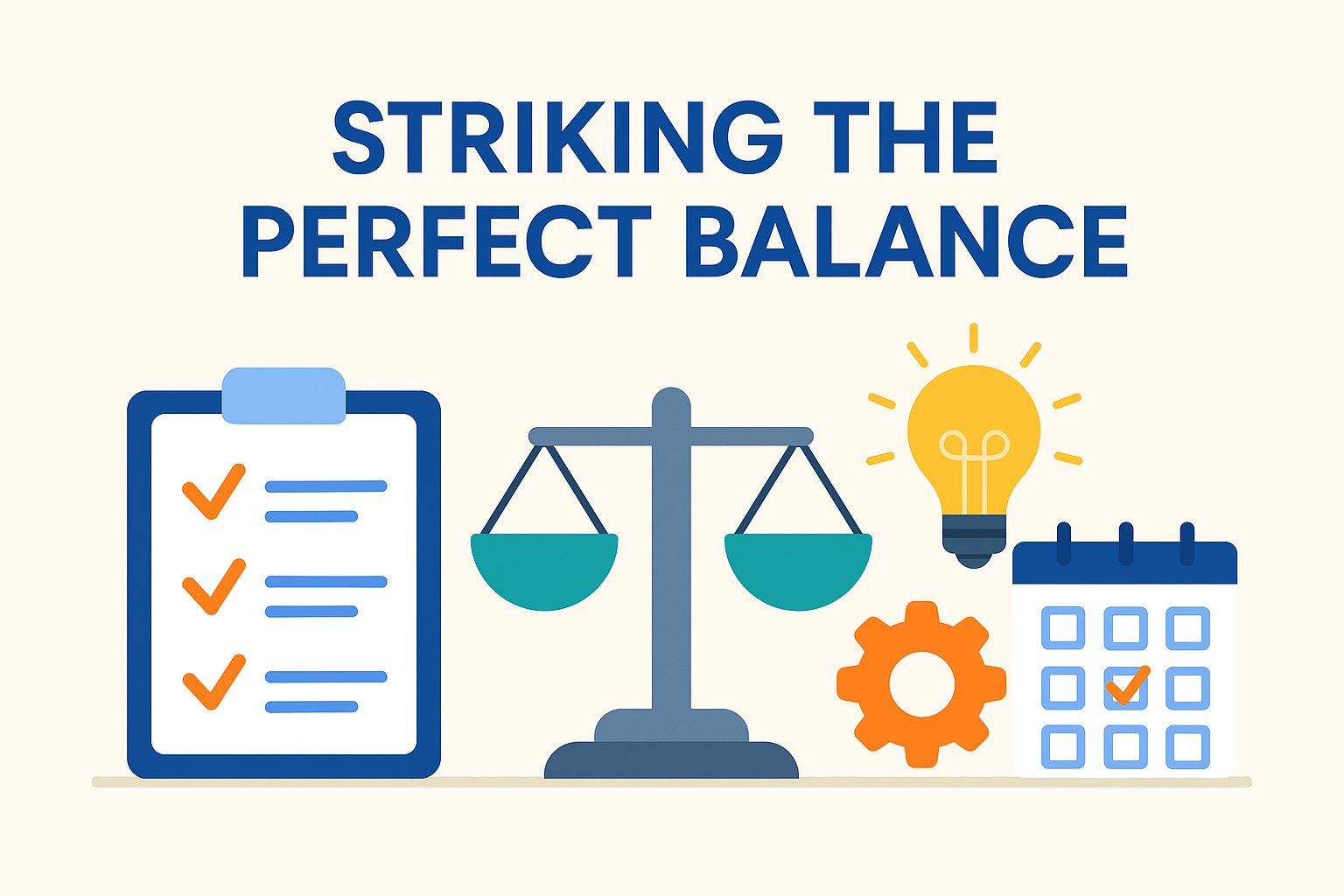How to Balance Creativity and Efficiency in Content Creation Teams
Learn how to boost creativity and productivity in your content team without compromise. Discover strategies to balance ideas and deadlines through efficient workflows, automation, and better collaboration.

Balancing Creativity and Efficiency in Content Creation Teams
Content creation is a fine balance between being able to be creative and following strict rules. On the one hand, teams need space to try new things, come up with new ideas, and make interesting things. On the other hand, order and efficiency are needed for things like deadlines, paperwork, and strategy goals. The real test is to find the sweet spot where efficiency doesn't stop new ideas and imagination can thrive without chaos.
The Struggle Between Structure and Creativity
Too much organization runs the danger of suppressing original thoughts. Content producers will struggle to develop if they are buried behind inflexible regulations, limitless permissions, and micro-managed systems. Conversely, too much creative freedom could result in missed deadlines, inconsistent message, and a lack of purpose. Content teams running without defined procedures cause projects to drag out and result in piling-on changes.
As an example, think about a marketing firm. When a content writer spends days perfecting a blog post and then gets three rounds of feedback that doesn't agree with them and requests for changes that aren't clear, they get angry. While this is going on, artists who are waiting for finished copy have to rush to meet their own targets. This back-and-forth delays publication, and what should’ve been a simple process turns into a bottleneck.
Streamlining Workflows Without Killing Originality
How therefore can teams guarantee effectiveness without reducing the creative process to a manufacturing line? The secret is organized flexibility—building systems that direct content creation without micromanaging every action.
- Define roles clearly – Writers, designers, editors, and managers should know their responsibilities and when their input is required.
- Create an approval process that moves, not stalls – Too many approval layers can slow content down.
- Work together tools to keep everything in one place. Don't send comments in different emails, chat apps, and sharing documents.
This is where sites like EasyContent come in handy. Teams don't have to switch between different tools because EasyContent keeps everything in one organized but open place. Assignments, feedback, approvals, and revisions stay centralized, ensuring content flows smoothly from ideation to publication—without unnecessary delays or confusion.
Finding the Right Balance
For content teams to work at their best, they need both order and creativity. Artists can focus on what they do best—not on getting rid of spontaneity—if they get rid of things that waste time. A streamlined approach frees up time for real innovation instead of process problems, whether it's writing for a blog, social media, or in-depth research.
This blog will talk about ways that teams can improve their processes, make them more creative and efficient, and make sure that content is created smoothly without losing its uniqueness. There is no doubt that these ideas will help you stay creative, organized, and productive, no matter how big or small your organization is.
Key Takeaways
- Balance structure with creative freedom to avoid bottlenecks and delays.
- Streamlined workflows improve both speed and quality of content delivery.
- Clearly defined roles and responsibilities prevent confusion and duplication.
- Centralized collaboration tools like EasyContent reduce inefficiencies.
- Automating repetitive tasks frees up time for high-value creative work.
- Content calendars and approval systems keep production consistent and aligned.
- Regular brainstorming and repurposing ideas maintain energy without burnout.
- Track performance with KPIs that measure both productivity and impact.
The Common Struggle: Creativity vs. Deadlines
Every content team has been there: they want to make great content but they have to rush to meet schedules. There is always a fight. On the one hand, you need time to come up with ideas, make changes, and write interesting material. On the other hand, tight goals and plans force people to move quickly. As a result? Either perfection is valued more than creativity, or schedules are pushed back to make room for it.
The Quality vs. Speed Dilemma
Many content teams struggle with over-planning and under-planning at different times.
- Over-planning means getting stuck in endless meetings, approval loops, and perfectionist tendencies. The content is polished, but it takes way too long to publish.
- Under-planning means rushing through projects without clear guidelines. The result? Confusing messaging, inconsistent branding, and lots of last-minute changes.
Neither approach works well. Too much structure slows teams down, and too little structure creates chaos. The trick is finding a balance where teams have the creative freedom to do their best work while meeting deadlines without stress.
Real-World Example: A Content Team Stuck in the Loop
Let's look at the case of a marketing firm that is growing. Their content team was in charge of social media, email marketing, and blog posts. What's wrong? There was nothing coming out on time.
- Too much time was spent coming up with ideas without a clear plan.
- There were a lot of rounds of vague comments in emails, Slack, and shared documents that editors had to deal with.
- Designers had to wait for content to be finished, which caused design rushes at the last minute.
As a result? There were missed dates, angry team members, and clients who didn't understand why content was always late.
How They Fixed It
Instead of overhauling their creative process completely, they streamlined their workflows using EasyContent.
- Clear roles and responsibilities were set up so that everyone knew what their job was.
- It was set up so that material would move to the next step automatically instead of getting stuck in long email loops.
- The centralized tool from EasyContent helped them keep track of drafts, comments, and decisions all in one place.
Because of these small changes, their material went from being constantly held up to having a regular, well-organized flow. They found a way to do both, so they didn't have to choose between speed and quality.

Setting up a Methodical but Still Adaptable Workflow
Keeping organization and new ideas in check in a content process is like walking on a wire. Teams feel trapped when there is too much order. If you don't do enough, chaos will break out. The key is to come up with a method that gives people direction without stifling their creativity.
Step 1: Define a Clear Yet Adaptable Workflow
A content workflow isn’t just about moving tasks from point A to point B. It should allow for both efficiency and creativity. Here’s a basic framework that works well for most teams:
- Writers, designers, and strategists co-create ideas and plans.
- Writing the initial draft guarantees congruence with the tone and messaging of the brand.
- While designers get images ready, editors polish the material.
- Approval: Stakeholders give final material the all clear.
- Publishing and Distribution: The material is distributed throughout pertinent outlets.
This framework guarantees that every bit of material follows a procedure free from rigidity.
Step 2: Assign Clear Roles Without Micromanaging
A successful content workflow depends on well-defined roles. Everyone should know what they’re responsible for, but they also need creative freedom to bring their best work forward.
- Writers should concentrate on research, narrative, and creating engaging material.
- As you polish the last message, guarantee consistency, tone, and clarity.
- Designers: Create images that accentuate the material instead of considering it as a side issue.
- Project managers guarantee nothing goes through the gaps and oversee approvals and timeframes.
The game is to Have faith in your staff. While maintaining cooperation, give them responsibility over their chores.
Step 3: Use Content Calendars and Approval Systems for Flow
A content calendar keeps things running smoothly without feeling like a restriction. It helps teams:
✔ Plan content in advance so there’s no last-minute rush.
✔ Ensure deadlines are realistic and achievable.
✔ Align content production with marketing campaigns and seasonal trends.
On the other hand, a review system makes sure that material goes forward without any needless delays. Companies can use tools like EasyContent to speed up the review process so they don't have to wait for endless email loops.
Step 4: How EasyContent Helps Keep the Balance
Here’s where EasyContent makes a difference—it automates workflows without disrupting creativity. Instead of jumping between multiple tools, teams can:
🔹 Collaborate in real-time – Writers, editors, and designers work together in one place.
🔹 Track progress – No more guessing which stage the content is in.
🔹 Automate approvals – Keep projects moving without manual follow-ups.
🔹 Manage feedback seamlessly – No more scattered notes across emails and Slack.
With EasyContent, teams don’t have to choose between speed and creativity—they get both.
Getting People to Work Together Without Making Things Too Hard
A content team's success depends on how well everyone works together. But let's be honest: too much back and forth can make even an easy job into a grind that never ends. Long feedback loops, rewrites all the time, and unclear goals not only slow things down, they also kill innovation. So, how can you get people to work together effectively without making things too hard?
1. Avoid Endless Feedback Loops
Anyone who has read a blog post and asked for feedback has seen this happen: all of a sudden, everyone has an opinion. The person in charge of marketing wants a different hook, the sales team has ideas for new angles, and the SEO team offers keywords. As soon as you think you remember the first draft, it's gone.
The key is to set limits on feedback rounds. Instead of allowing unlimited revisions, define a structured process:
✔ First round – Initial review for tone, accuracy, and messaging.
✔ Second round – Final refinements and sign-off.
✔ Done – Publish and move forward.
By keeping feedback structured, teams avoid over-editing and focus on producing great content faster.
2. Set Clear Revision Guidelines
Not all feedback is useful, and not all suggestions need to be implemented. Teams should agree on:
The people who give feedback don't all have to say something. Assign different users to different types of feedback, such as SEO, brand message, and readability.
When you get comments, give people due dates for turning in their changes. No changes at the last minute!
How the feedback is organized – Instead of notes like "this doesn't work," ask for feedback that is clear and can be used. (For example, "Can we shorten this sentence?")
A organized editing process helps designers and writers make changes that matter without having to waste time rewriting things over and over again.
3. Use Centralized Tools to Manage Feedback
One of the biggest reasons collaboration gets messy? Scattered communication. Feedback is left in email threads, Slack messages, Google Docs comments, and sometimes even in separate PDFs. This leads to confusion, duplicate work, and frustration.
A centralized platform like EasyContent keeps everything in one place. Instead of bouncing between multiple tools, teams can:
🔹 Leave comments directly on drafts – No need to chase down emails.
🔹 Track changes in real-time – Always work with the latest version.
🔹 Automate approvals – No more waiting on manual follow-ups.
🔹 Assign specific tasks to team members – Keep things moving without micromanagement.
With EasyContent, teams don’t waste time searching for feedback—it’s all in one organized workspace.
4. Best Practices for Remote & Hybrid Collaboration
For remote and hybrid teams, the lack of in-person interaction can sometimes lead to miscommunication and delays. To keep everyone aligned:
✅ Have a kickoff call – Before starting a project, get everyone on the same page.
✅ Use async collaboration – Not everyone works in the same time zone. Let people review and contribute on their schedule.
✅ Set clear deadlines – Without structured deadlines, projects can drag on indefinitely.
✅ Encourage concise communication – Long emails and Slack messages slow things down. Keep it brief and to the point.
Automating Tasks That Are Done Over and Over Again to Make Time for Creativity
Every content team knows how hard it is to get things done on time, get approvals, stick to releasing plans, and not miss anything. What's wrong? It's hard for people to be creative because they spend so much time on boring, repetitive tasks. What if there was a way to get rid of these slowdowns without losing control of the content process? This is where technology comes in handy.
Why Automation is a Game-Changer for Content Teams
Most creative professionals don’t want to spend hours chasing approvals, assigning tasks, or manually scheduling posts.Too much time spent on boring routine tasks leaves little time for coming up with new ideas, improving brand style, or trying out new ways to present interesting content.
By automating these tasks, teams have more time to do creative work, which is what gets people interested, builds brand identity, and makes businesses stand out.
What Can Be Automated?
Automation doesn’t mean replacing human input—it means removing roadblocks so that teams can work smarter. Here’s how automation transforms content workflows:
✅ It's no longer necessary to send long emails or ask, "Did you see my message?" to get approval. Automated systems make sure that information moves quickly from the draft to the final review.
✅ Tech makes sure that the right people are told about jobs at the right time, so you don't have to hand them out by hand. No more missing due dates because someone forgot their turn.
✅ If you can use tools to organize your information and post it for you, why do it by hand? Automating email marketing, social media updates, and blog entries ensures that content reaches individuals at times most likely to be interested in it.
Case Study: How Automation Helped One Marketing Team Be More Creative
Content delays happened at a medium-sized marketing firm because decisions took too long, deadlines were missed, and too many follow-ups had to be done by hand. The people who worked on their content spent more time handling the process than making content.
After integrating EasyContent, they:
🚀 Automated their approval process, reducing delays by 50%.
🚀 Used task automation, ensuring everyone knew their responsibilities without micromanagement.
🚀 Scheduled content in advance, freeing up time for brainstorming and experimentation.
That leads to With three months of working on high-impact content instead of routine problems, the team got better at being creative.
How EasyContent preserves the creative energy while automating chores?
EasyContent is more than simply a content management tool; it's a productivity accelerator for teams trying to simplify their work without sacrificing creative flexibility. Teams equipped with built-in job duties, automatic approvals, and simple communication can:
✔ Spend less time on busywork and more time on content strategy.
✔ Eliminate bottlenecks that slow down production.
✔ Keep all feedback, approvals, and tasks in one place instead of scattered across emails and spreadsheets.

Avoiding Burnout: The Key to Sustainable Creativity
Creative teams often have to keep making high-quality work at a very fast rate while dealing with tight deadlines, multiple projects, and shifting goals. When things are just right, creativity can grow. But when standards are too high or production cycles never end, it can lead to burnout, which drains motivation and leaves even the most passionate content makers feeling uninspired.
So how do you keep your team energized, productive, and creative without running them into the ground? Here’s how.
The Risk of Getting Burned Out When Making Content
People who are burned out are not only tired, but also mentally and emotionally worn out. Their drive and creativity go down. It's not good for content teams to always have to meet goals because it makes their work worse.
🚨 Missed deadlines – Teams overwhelmed with work start to fall behind.
🚨 Lack of innovation – When creativity is rushed, content becomes repetitive and uninspired.
🚨 High turnover rates – Talented writers and designers won’t stick around if they feel overworked.
A poll by Gallup found that 76% of workers feel burned out at work at some point. Even more people may be hired for creative jobs because content teams are often asked to keep making new, interesting material.
Getting and keeping teams motivated
Teams need balance—a organized process that still lets people be creative—so they don't get burned out. To keep your content team inspired and working hard, try these easy but effective tips:
✅ Encourage Brainstorming Sessions – Giving writers and designers the space to collaborate and bounce ideas can reignite their enthusiasm. Instead of forcing last-minute content, schedule regular brainstorming meetings where creativity can flow without pressure.
✅ Give your team time to think and work. They will get tired quickly if you expect them to work nonstop. To clear their thoughts, tell them to take a 10-minute walk, have a casual team chat, or work on personal projects that aren't related to their job.
✅ Set deadlines that you can meet – Content that is rushed often results in poor work and extra stress. Allow your team enough time to create content that really does what it says it will do. You can plan and automate processes with tools like EasyContent to make sure you meet goals without any last-minute chaos.
How Powerful It Is to Reuse Content
One of the worst things that content teams do? Always starting from scratch when making new material. Successful teams don't keep making new things from scratch; instead, they make the most of what they already have to work better, not harder.
🔄 Turn blog posts into LinkedIn threads or Twitter snippets.
🔄 Repurpose long-form articles into bite-sized Instagram carousels.
🔄 Convert webinars into blog recaps, infographics, or YouTube shorts.
By using a strategic repurposing approach, teams can increase output without increasing workload. Platforms like EasyContent make it simple to organize, track, and repurpose content efficiently, so no great idea goes to waste.
Measuring Success: Finding the Right Balance
Each group has to figure out how to make things quickly and in their own unique way. It's important to have goals, but what good is content that no one wants to read? But if your only goal is to be different and you forget to plan anything else, you might run into problems and delays.What does success look like for businesses trying to avoid overly emphasizing speed or stifling innovation?
Using the suitable key performance indicators (KPIs) helps one to keep an eye on both efficiency and creativity. Real data should also assist to enhance processes. Let's see how teams could strike the ideal balance and continue to improve.
Tracking Efficiency vs. Creativity
Measuring content success isn’t just about publishing on time—it’s also about how well the content performs and resonates with audiences. Here’s how to evaluate both sides:
📌 Efficiency Metrics (Process-Focused)
- Deadlines Met: The percentage of information that was posted on time.
- Content Output – Number of posts, videos, or articles completed in a set timeframe.
- Revision Cycles – How many rounds of edits a piece requires before approval.
- The average amount of time it takes to get information signed off on.
👌 Creativity Measures (Impact-Focused)
- Shares, comments, favorites, and time spent on material define engagement rate.
- Audience Development: Either new members, subscribers, or repeat guests.
- Conversion Rate: Content produced signs-ups, downloads, or sales.
- Keyword success, more search engine traffic, and better outcomes define your SEO performance.
💡 For instance, EasyContent allowed a content marketing team struggling with overly long approval waiting times to quickly sift comments and assign tasks. In just two months, the time it required to turn in work reduced forty percent; the quality stayed the same.
KPIs—or Key Performance Indicators—for Content Success Teams who adopt the right KPIs might be fact-based and still have creative freedom. Some important KPIs worth keeping an eye on are:
📊 Production KPIs
✔️ Every month fresh material is published
✔️ Time it takes from a concept to publication: Before last approval, how many adjustments are needed?
📊 Performance KPIs
✔️ Traffic and original page views.
✔️ Typical article or video engagement time
✔️ Social media highlights and shares.
📊 Conversion KPIs
✔️ Leads produced from content
✔️ Click-through rates on CTAs
✔️ Percentage of readers acting—subscribing, buying, etc.
Using feedback and analytics to improve workflows
After setting KPIs, the next step is to change tactics based on what you've learned. Here's how teams can keep getting better:
📌 Use Audience Feedback – Comments and social reactions can reveal what content resonates most
📌 Optimize Based on Performance Data—If a piece doesn't do well, change the style, title, or way it's distributed.
📌 A/B Test Different Approaches – Try variations of the same content to see what works best.
📌 Improve Internal Workflows – If approval times are slowing things down, streamline review cycles and automation with tools like EasyContent to reduce bottlenecks.

Striking the Perfect Balance
For content teams striving to generate excellent work without missing deadlines, juggling creativity with efficiency is not only a goal but also a need. A team that veers too far toward structure runs the danger of losing its creative spark; a team that concentrates just on creativity runs the danger of disintegrating. The secret is to strike a compromise whereby procedures direct the process without limiting creativity.
The Importance of Balance
A well-organized content process keeps projects on track, but it should also allow for quick ideas, creativity, and adaptability. It's more like a framework than a strict set of rules. It gives people security while still letting their creative thoughts explore ideas.
For example: let us think about A marketing firm had problems with inconsistent quality and missed dates because writers and designers worked alone. Version control issues led to confusion across the different sites where feedback was sent. They gave their creatives more time to work on their ideas, made reviews easier, cut down on changes that weren't needed, and got 30% more content created in 30% less time after moving to EasyContent.
How Workflows, Collaboration, and Automation Work Together
📌 Structured Workflows for Clarity
- Defining clear roles and responsibilities keeps projects on track.
- Content calendars provide a roadmap for production without overloading the team.
- Approval systems help ensure quality control without delays.
📌 Collaboration Without Chaos
- Feedback, changes, and decisions are all kept in one place by centralized systems like EasyContent.
- Clear review rules cut down on pointless emails back and forth.
- Real-time collaboration enables teams to work faster and smarter.
📌 Automation to Save Time
- Task allocations and approvals automated reduces obstacles.
- Planned publication guarantees material consistency across media.
- Tools driven by artificial intelligence assist maximize material without sacrificing uniqueness.
Last Notes: Efficiency and Creativity Can Live Together
Though many teams worry that introducing structure would stifle innovation, the fact is that the correct approach actually frees time for creative output. Instead of wasting hours tracking approvals or searching for the latest draft, content creators can focus on what they do best—producing engaging, high-quality content.
By using tools like EasyContent, teams can create an efficient, organized workflow while giving creatives the space to explore ideas. As a result? A content machine that works well without losing its uniqueness.
Now is the time to find the right mix for your team if they are having trouble with delays, feedback loops that are out of order, or bottlenecks. There are a lot of options when imagination and efficiency work together.






